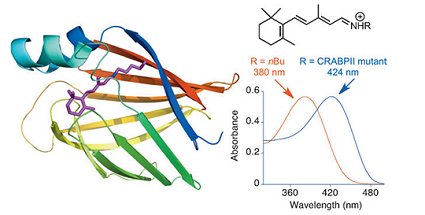Rhodopsins consist of opsin (light-sensitive proteins) and retinal. They are the sensor molecules responsible for visual perception. The observed changes in the absorption profile of the bound retinal results in the modulation of its absorption spectrum from approximately 400 to 600 nm. However, it is difficult to pinpoint the subtle factors responsible for this wavelength shift.
From Michigan State University in the US comes a study describing a clever approach to examining wavelength regulation in the context of basic physical organic principles. Babak Borhan, James H. Geiger, and co-workers have designed a rhodopsin protein mimic. They show how wavelength absorption can be drastically tuned by completely encapsulating the β-ionone ring in the protein scaffold and changing the electrostatic potential in the binding pocket (see figure).

This work is set to lay the foundation for our understanding of color perception.
Image: © Wiley-VCH
- Probing Wavelength Regulation with an Engineered Rhodopsin Mimic and a C15-Retinal Analogue,
K. S. S. Lee, T. Berbasova, C. Vasileiou, X. Jia, W. Wang, Y. Choi, F. Nossoni, J. H. Geiger, B. Borhan,
ChemPlusChem 2012.
DOI: 10.1002/cplu.201100082
This article is available for free as part of the ChemPlusChem free trial.




